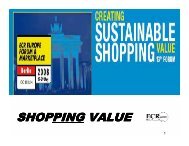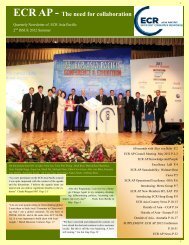You also want an ePaper? Increase the reach of your titles
YUMPU automatically turns print PDFs into web optimized ePapers that Google loves.
Fixed constraints include:<br />
• Transport infrastructure such as streets, bridges<br />
and tunnels<br />
• Outer truck length, width and height, closely linked<br />
to traffic infrastructure and also regulated by the<br />
European Directive (96/53/EC)<br />
• Inner truck width, closely linked to outer<br />
truck width<br />
• Consumer household constraints such as cupboards,<br />
fridges, and plates<br />
• Consumer requirements such as the size of a food<br />
portion<br />
• Consumer and employee ergonomics, defining what<br />
an average person can lift, reach, hold and move<br />
without strain or risk of injury<br />
Currently regarded as variable constraints, within<br />
a long-term fixed limit:<br />
• Inner truck height. Technical developments will<br />
permit more efficient use of truck height to improve<br />
inner height. Fixed outer truck height imposes a<br />
long-term limit<br />
• Inner truck length, set by the fixed outer length.<br />
Technical improvements are still possible<br />
• Pallet and roll cage plan dimensions, linked to inner<br />
truck width.<br />
Variable, largely company-specific or local<br />
constraints are:<br />
• Production facilities, including factory layouts,<br />
production and packing lines<br />
• Warehouse layouts<br />
• Warehouse racking slots<br />
• Retail store layouts<br />
• Shop shelf dimensions<br />
• Primary product dimensions<br />
• Operating methods.<br />
28<br />
Accept fixed and challenge<br />
variable constraints<br />
Unit loads are restricted by many factors. A whole set<br />
of constraints results from supply chain infrastructure,<br />
such as trucks, racks, doors and handling equipment,<br />
which mostly affect tertiary unit loads. Constraints<br />
imposed on primary products also have an influence<br />
on unit loads. These include production lines, shop<br />
shelves, cupboards, refrigerators and even plate size.<br />
Other constraints on unit loads are derived from<br />
market requirements, consumer and employee<br />
ergonomics, operational methods and legislation.<br />
There is a distinction between fixed and variable<br />
constraints. Only long-term fixed constraints that<br />
cannot be bypassed are to be viewed as ultimately<br />
restrictive. All other constraints must be challenged.<br />
Only long-term fixed constraints should limit the<br />
Efficient Unit Loads design. The validity of<br />
constraints must be challenged.<br />
Efficient Unit Loads seek the optimum ‘total supply<br />
chain’ solution within all genuine constraints.<br />
Supply chain capacity has a space and<br />
time dimension<br />
Capacity at any point in the supply chain can be<br />
defined by the modular spaces available. For activities<br />
involving the handling and moving of products,<br />
availability has a time dimension. Efficient use of<br />
available capacity requires optimal scheduling. <strong>ECR</strong><br />
Europe has addressed this issue in the Efficient<br />
Replenishment project. This EUL Report only addresses<br />
physical elements and not time elements of capacity.<br />
EUL supply chains can be realised if structures,<br />
capacities, activities and unit loads are designed in<br />
close co-operation.<br />
The Efficient Unit Loads Report










